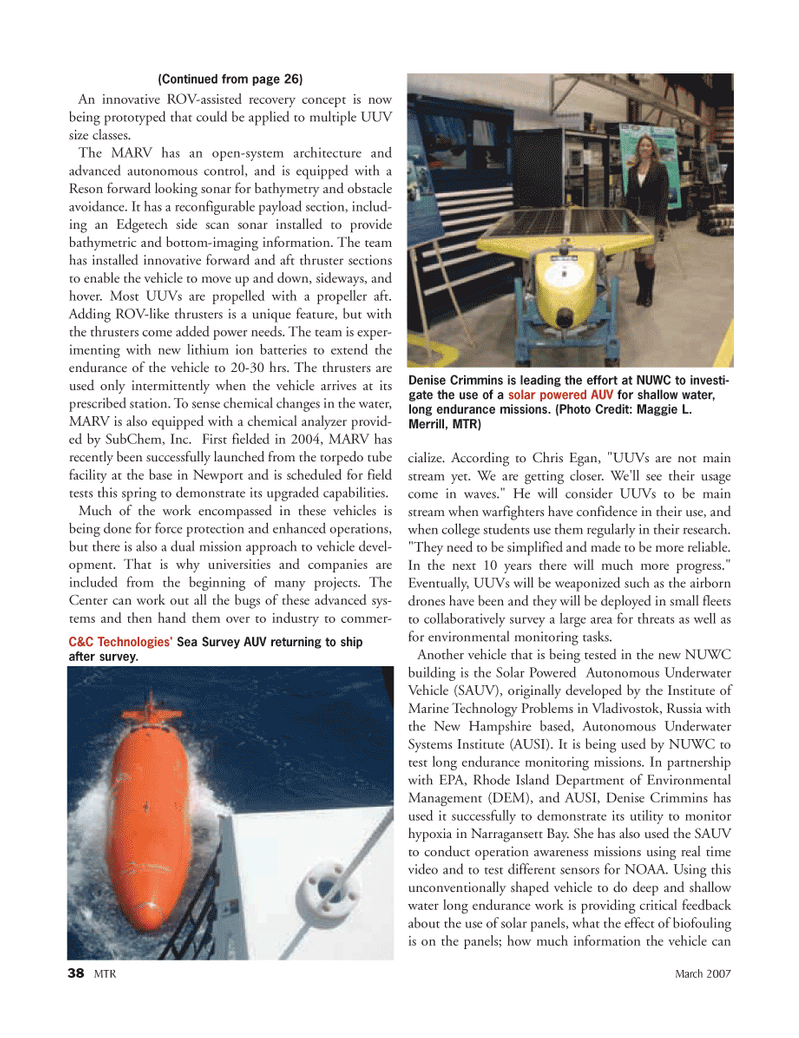
Page 38: of Marine Technology Magazine (March 2007)
AUVs, ROVs, UUVs
Read this page in Pdf, Flash or Html5 edition of March 2007 Marine Technology Magazine
38 MTR March 2007
An innovative ROV-assisted recovery concept is now being prototyped that could be applied to multiple UUV size classes.
The MARV has an open-system architecture and advanced autonomous control, and is equipped with a
Reson forward looking sonar for bathymetry and obstacle avoidance. It has a reconfigurable payload section, includ- ing an Edgetech side scan sonar installed to provide bathymetric and bottom-imaging information. The team has installed innovative forward and aft thruster sections to enable the vehicle to move up and down, sideways, and hover. Most UUVs are propelled with a propeller aft.
Adding ROV-like thrusters is a unique feature, but with the thrusters come added power needs. The team is exper- imenting with new lithium ion batteries to extend the endurance of the vehicle to 20-30 hrs. The thrusters are used only intermittently when the vehicle arrives at its prescribed station. To sense chemical changes in the water,
MARV is also equipped with a chemical analyzer provid- ed by SubChem, Inc. First fielded in 2004, MARV has recently been successfully launched from the torpedo tube facility at the base in Newport and is scheduled for field tests this spring to demonstrate its upgraded capabilities.
Much of the work encompassed in these vehicles is being done for force protection and enhanced operations, but there is also a dual mission approach to vehicle devel- opment. That is why universities and companies are included from the beginning of many projects. The
Center can work out all the bugs of these advanced sys- tems and then hand them over to industry to commer- cialize. According to Chris Egan, "UUVs are not main stream yet. We are getting closer. We'll see their usage come in waves." He will consider UUVs to be main stream when warfighters have confidence in their use, and when college students use them regularly in their research. "They need to be simplified and made to be more reliable.
In the next 10 years there will much more progress."
Eventually, UUVs will be weaponized such as the airborn drones have been and they will be deployed in small fleets to collaboratively survey a large area for threats as well as for environmental monitoring tasks.
Another vehicle that is being tested in the new NUWC building is the Solar Powered Autonomous Underwater
Vehicle (SAUV), originally developed by the Institute of
Marine Technology Problems in Vladivostok, Russia with the New Hampshire based, Autonomous Underwater
Systems Institute (AUSI). It is being used by NUWC to test long endurance monitoring missions. In partnership with EPA, Rhode Island Department of Environmental
Management (DEM), and AUSI, Denise Crimmins has used it successfully to demonstrate its utility to monitor hypoxia in Narragansett Bay. She has also used the SAUV to conduct operation awareness missions using real time video and to test different sensors for NOAA. Using this unconventionally shaped vehicle to do deep and shallow water long endurance work is providing critical feedback about the use of solar panels, what the effect of biofouling is on the panels; how much information the vehicle can (Continued from page 26)
C&C Technologies' Sea Survey AUV returning to ship after survey.
Denise Crimmins is leading the effort at NUWC to investi- gate the use of a solar powered AUV for shallow water, long endurance missions. (Photo Credit: Maggie L.
Merrill, MTR)
MTR#2 (33-48).qxd 3/2/2007 11:18 AM Page 38

 37
37

 39
39
